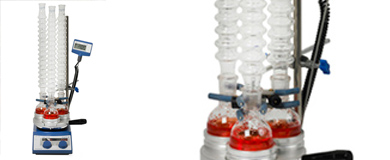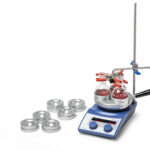Parallel synthesis is a method that is frequently used when researchers are looking to speed up the discovery of new compounds as well as carry out screening for the most suitable process conditions. This blog post will briefly introduce the parallel synthesis technique and cover some of its applications and benefits.
What is Parallel Synthesis?
Parallel synthesis is a popular method for developing chemical libraries, which typically only include compounds with variations in stereoisomerism, substituents and functional groups. Parallel synthesis often supports this process when searching for potential drug candidates in the pharmaceutical industry by enabling simultaneous processing of multiple reactions.
When searching for lead compounds, a process we will outline below, parallel synthesis plays an essential role in speeding up the synthesis of thousands of molecules. By reducing the number of sequential steps, the process is no longer the time-consuming, unpredictable process it once was.
In drug discovery, scientists identify a target molecule that is connected to a disease process. Once the target molecule has been verified,scientists look for a (lead) molecule that acts on this target molecule. To carry out this process, many molecules will need to be synthesised and screened for interactions with the target molecule before the lead molecule is found.
What Are The Applications of Parallel Synthesis?
Suitable for several vital processes, parallel synthesis is used across the pharmaceutical and chemistry industries. Some applications include the following:
- Combinatorial Chemistry: Parallel synthesis is carried out with chemical reactors to create large sets of biologically active compounds in a more focused way that allows specific products to be tracked throughout the process.
- Developing Compound Libraries: Compound libraries are essential in drug discovery. A compound library holds specific chemicals grouped by structural similarity that scientists can utilize for screening and other processes.
- Drug Discovery and Development: New potential drug candidates can be discovered and developed through parallel synthesis as it enables scientists to synthesize libraries with diverse chemical structures.
- Therapeutics Profiling: To find new treatments for diseases that cause inflammation in patients, scientists can undertake therapeutic profiling with the help of parallel synthesis.
What Are The Benefits of Parallel Synthesis?
There are several benefits to using parallel synthesis in the applications mentioned above. It is faster and more refined than previously used methods, allowing multiple experiments to be carried out simultaneously.
When scientists work with large compound libraries, knowing what entities are in the library can be challenging. However, parallel synthesis makes it much easier to identify and prepare the individual compounds for use.
The technique is used to accelerate the discovery of new compounds and can also work to speed up the process of screening for optimal process conditions.
Key benefits:
- Categorize A Large Number of Compounds
- Easy Method
- Highly Efficient
- Identify Important Compounds
- Quick and Time-Saving
Parallel Synthesis at Asynt
At Asynt, we develop and manufacture a range of products suitable for synthesis procedures. Whether carrying out single or multiple reactions, our DrySyn range of laboratory heating blocks offers the perfect solution.
For more information on parallel synthesis or any of our products, please don’t hesitate to contact us.








